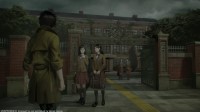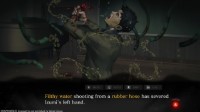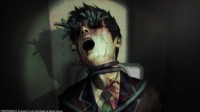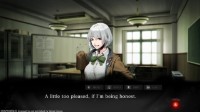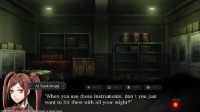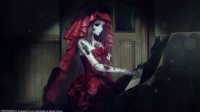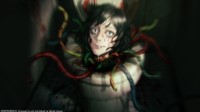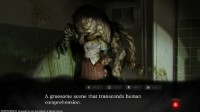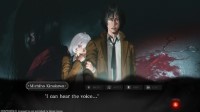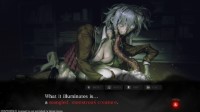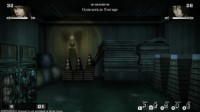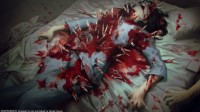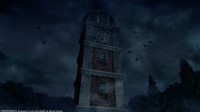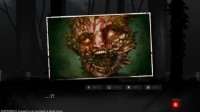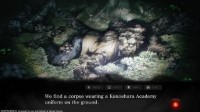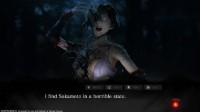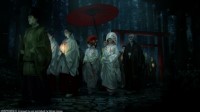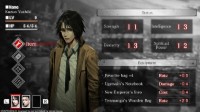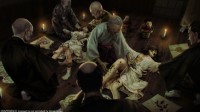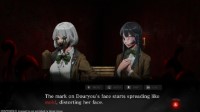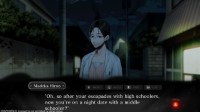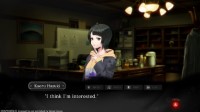Death Mark II
Playtime: 17.0 Hours
Finished 11 October 2025.Played the game on the Switch, referencing a walkthrough because I typically don't handle horror games very well. I got all of the collectibles which are required to fully unlock every character profile, but only did the "Good" routes for each chapter. Played through with the Good Ending first, then went back through the True Ending afterward, which probably only deviates a total of ~20-30 minutes from the Good ending.
The third entry in the Spirit Hunter series essentially follows the same formula as the previous two, with some minor modifications. It's primarily a horror VN/ADV hybrid, themed around paranormal Japanese spirits that must be exorcized, rather than slasher villains, mutants, or other "generic" foes that are more typical in horror. However, what really sets these games apart for me is that most of the spirits you face are not inherently violent or malicious; as explained in the story, they only exist because people who held a strong grudge in death could not make it peacefully to the afterlife. A big part of these games involves discovering the original reasons why the spirits exist and finding out how they can be appeased, thematically blending the horror elements with detective or mystery-style writing. It's not all sunshine and rainbows, though; the spirits still claim numerous victims, and encounters with them are no less dangerous even knowing the full truth.
This game once again stars Yashiki (real name Kujou Masamune) as the main character, taking place shortly after the events of Death Mark 1, likely some time around the turn of the 21st century. This places it a few years before the events of NG in the timeline, but this isn't particularly relevant outside of a young Kaoru Hazuki's presence in the EX chapter, given that DM1 & NG don't share many characters. Unlike the first game, however, Yashiki does not have any personal motivations for this ordeal, but rather shows up at Konoehara Academy to investigate rumors of "The Departed" based off the recommendation of his friend. This only lasts a short while, given that the Departed ends up taking an interest in him after the opening chapters, but the initial motivation to figure out this mystery certainly feels a bit weaker than the prior games. For the most part, each of the cases is centered around this school and its surroundings; the Departed is primarily a background force throughout the majority of the game while various spirits haunting the Academy take the forefront. The story explains this by implying the Departed's powerful presence has stirred up several other spirits, but it does feel a bit strange in practice; I feel like the Departed kind of "takes over" the atmosphere in a few chapters, and the number and depth of the actual spirit cases suffers a bit for it. This is especially true when trying to analyze the different episodes - of the 7 episode story, the Departed takes a central focus in 4 of them: 1, 4, 6, 7. This leaves only 3 other major spirit cases (there's a 5-minute encounter with another spirit in Chapter 4): Hanako, Kashima, Kokkuri. It kind of feels a bit emptier than the wide rosters presented in the previous games, which were also able to have great overarching storylines all the while.
Another, perhaps more significant change to the fundamental gameplay of DM2 is the inclusion of active movement controls; for the first time, you're able to actually walk around the environments and examine things from a side-scrolling perspective, as opposed to the screen-based movement of the other games. This is the most obvious reason why so much of the game takes place in the same repeated locations; the New Building, the Old Building (which has the same layout), the Forest, etc. The entire map has to be interconnected in order for the game to feel fluid, and the sacrifice they've made for now is to focus on letting you explore different parts of the same general areas. I hope this doesn't persist into any future entries; it's not too awful in my opinion, but I'd definitely like to see more exotic and interesting locations, rather than the same hallways for 15 hours. Even the same forest layout is used twice, between the Kokkuri & final Departed cases! I'm ultimately not too sure how to feel about this change overall, because I do feel that the game feels more fluid now than with the awkward menu-based navigation it had before. There are still plenty of static scenes that maintain a first-person perspective in the same vein as the original, and I feel like those are able to evoke a much creeper atmosphere than all the hallways in the school and beyond.
Yet another changed aspect about the core gameplay involves the way you make choices, especially for the "Suspensive Acts" - typically reserved for high-danger situations when you face off against a spirit. You're no longer timed as you were before, removing the pressure to quickly decide and input your choices; instead, spirits will patiently wait for you to make your decisions, but all choices now have an associated spirit point (SP) cost, and only have a percentage chance to succeed, regardless of whether the decision is correct or not. For example, the correct choice can still fail if you're unlucky, and you can also successfully execute the wrong choice (but will obviously incur unwanted penalties afterwards). If you fail the roll, the game typically just implies you had butterfingers or were too anxious to perform your action, letting you try again without any real penalties unless you lose all your SP. This is kind of an awkward system; I kind of prefer it to the hard time limit since I don't like that pressure, yet it doesn't really do much. In any case, their implementation of this system opens up a motivation for you to thoroughly explore the map in each chapter, as there are "eerie teeth" hidden everywhere. Grabbing these will slowly level your characters, giving you a greater SP pool; also, they can be traded in for various artifacts that buff you - letting you take less damage, buffing your action chances, etc. This is nice because there are quite a few events in the game (outside of the Suspensive Acts) that will drain your SP, so these will all help you stay alive a little bit longer.
Since this game relies very heavily on returning characters from DM1 as your partners in DM2, I feel like the roster of completely new characters feels very limited. Other than having Mr. Konoe along for the very first chapter and Michiho/Himeko as partners for fairly brief periods in some of the later chapters, you're basically just reuniting with about half the cast of DM1. There's a couple other characters in Ms. Sakamoto & the weird kid Abe, but beyond that it's mostly victims and other minor characters. It's nice to see some familiar faces for sure, especially given that I quite liked the DM cast, yet I feel like it would have been nice to see more characters that had real connections to the school and to the case. Every time an old face showed up, they always had to justify themselves by saying "they couldn't just stay away from it", but it just can't feel as personal as their life-or-death consequences from DM1. It might also have made more sense if these cases weren't so heavily centered around the school, where there should've been hundreds of students or faculty that might have personal stakes - just saying. At the end of the day, though, I really liked how this game follows up on the ending of DM1 by actually showing how closely connected the original Mark Bearers remain, even after their own ordeals ended. I love how truly diverse the cast is; comprising people of all ages, occupations, and from all walks of life, and I hope to see the new DM2 characters return in some way further down the line to augment the roster. For example, now that Konoe resigned after all the ruckus, maybe he'll be a bit more willing to offer his help to others in the same predicament, given what he went through?
This kind of takes me to my final comments and opinions on the overarching story of this game; though the narrative as a whole feels a bit more compressed than the other games (regardless of actual playtime), the individual spirit episodes are still as good as ever. There's a balance that is struck between the tragedy of the victims and the tragedies of the spirits, and you can really end up empathizing with the spirits at times; for example, Izumi is butchered by Hanako in the opening chapter, yet you learn how he tortured Hanako to death in the following chapters, almost earning his fate. The game introduces a sort of "whodunit" plot early on, implying that the Departed is disguised as a student. You're led to suspect Michiho (correctly, I might add) pretty early on since she comes onto Yashiki pretty hard and has tons of obvious signs, yet as you learn later, the Departed is actually a pair of spirits borne from grudges held by girls who were sacrificed in an extremely gruesome manner to end a famine over a century ago. This second part of the twist is precipitated very well in my opinion; as you have to draw from the characteristics you learn about the Departed (two close sisters, their interests, etc.) to solve the mystery.
The endings of this game are great as usual; the mysteries are solved and the spirit is appeased and finally able to leave peacefully. This time, there's actually a distinction between the Good & True endings which requires a second playthrough - by convincing Ms. Sakamoto to get off your case, you save her life (by making the Departed lose interest in her) and somehow unlocking the chance to save the true Michiho & Himeko, who were in stasis in the Clock Tower while the Departed assumed their forms. I suppose it's not too hard to imagine something like this would happen, given how few new characters there are, but it's still nice to see several of the characters escape their fate. There's a bit of a weird situation brewing wherein the Departed's incredibly obsessive love for Yashiki somehow transferred in part to the recovering girls... everyone's aware enough of the situation to avoid falling into the obvious trap (plus the game makes it clear that the feeling are more "pure" and no longer tainted by the grudge), but it's still a bit sus nonetheless. Either way, I'm hoping to see more them in any prospective future entries since I liked their characters.
Even with all its technical shortcomings, I still absolutely loved this game; none of the "issues" were significant for me at all anyway, and I mostly listed them as nitpicks or minor annoyances rather than true criticisms against the decisions of the game. I've not mentioned anything about the visuals at all so far, but it's incredibly easy to see from the screenshots how masterfully the aesthetic of the game is carried out; it's pretty much unnecessary to speak further on it. The writing can obviously be a bit strange at times, but it didn't dull the impact of the themes presented in the game; beyond the more immediate effects of the gore and atmosphere, the game is able to portray not only the fear of the supernatural, but also all the kinds of very human cruelty that caused all these tragedies to begin with. Here's hoping any further entries in the series will maintain what Spirit Hunter 1-3 have been able to do so far.
